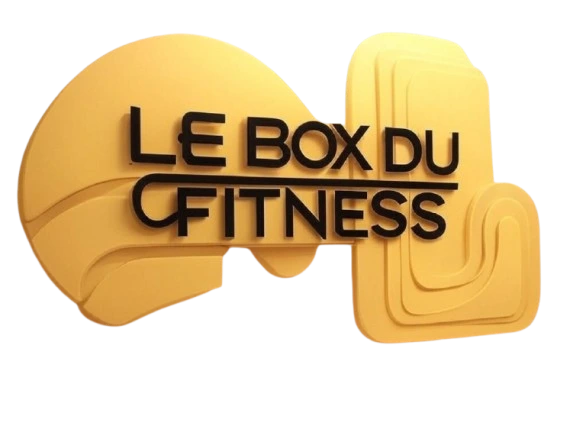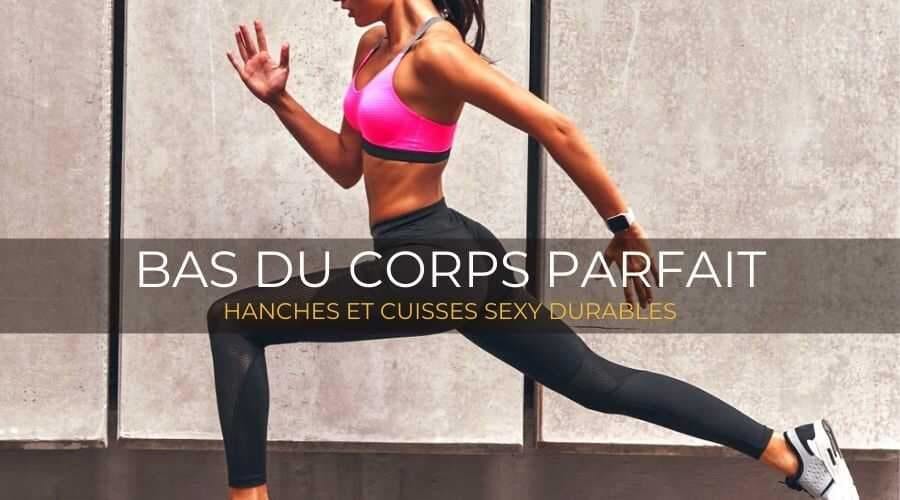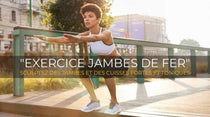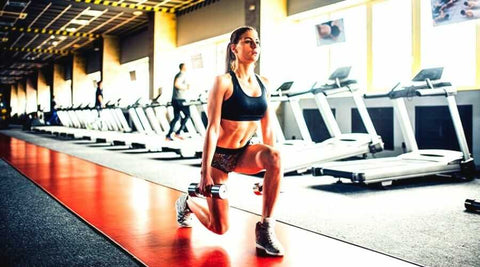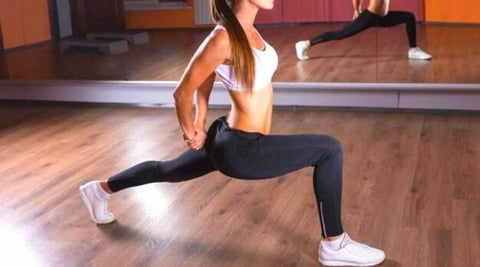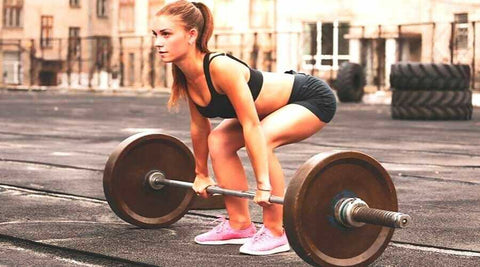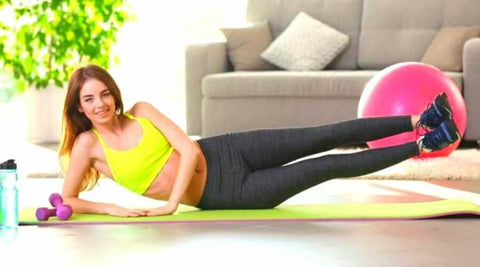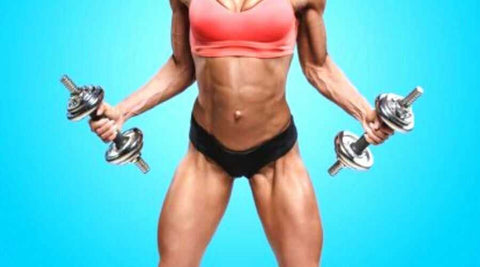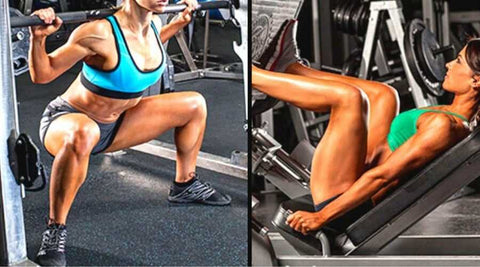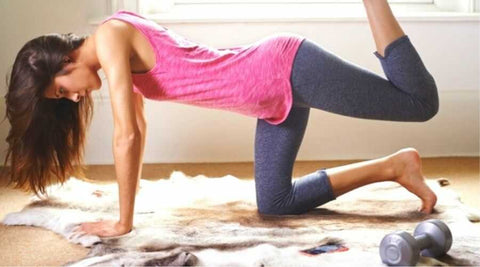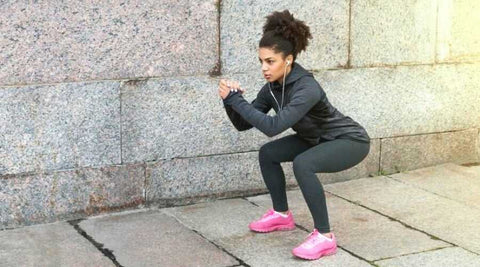1/ Sculpt a gravity-defying butt and sexy legs, hips and thighs with these five easy exercises.
Pendulum lift
What you will need: A step and a pair of 2.5kg dumbbells .
-
Standing with your right foot on the step and your left foot hanging behind you, hold a dumbbell in each hand, arms at your sides, palms facing back.
-
Keeping your right leg slightly bent, hinge forward from your hips while lifting your left leg behind you until your body is almost parallel to the floor and your hands hang below your shoulders.
-
Return to the starting point. Do 15 repetitions.
-
Switch legs; repeat.
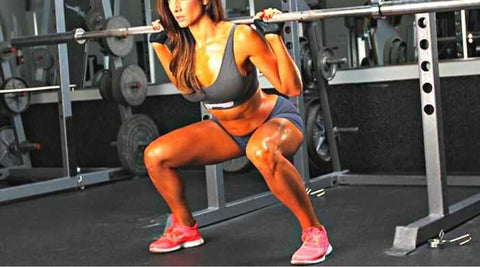
Squat one and a half
Targets: Buttocks, quads and hamstrings
-
Standing on a step with your feet shoulder-width apart, hold a dumbbell in each hand, arms at your sides, palms facing in.
-
Squat down until your thighs are almost parallel to the floor, keeping your knees behind your toes and your back straight.
-
Come back up halfway; hold for 2 seconds. Lower back down to a full squat.
-
Return to the starting point. Do 15 repetitions.
Knee pump
Targets: Hips, glutes and hamstrings
- Standing on the step with your feet hip-width apart, hold a dumbbell in each hand, elbows bent, palms facing in.
- Lean your upper body slightly forward and bend your right leg toward the floor (do not bend your knee).
- Keep your left knee bent behind your toes.
- Lift your right leg, bringing your right knee and left hand toward your chest. Bend your right leg back; lower your left arm.
- Do 15 reps. Switch legs;
- Repeat.
Seesaw standing
Targets: Shoulders, abs, hips and outer thighs
- Stand on a step with your right foot, left foot hanging out to the side, holding a dumbbell in your right hand at your side, left hand on your hip.
- Keeping your abs engaged and your back straight, slowly raise your left leg out to the side as high as possible while raising your right arm to shoulder level, palm facing down.
- Return to starting point. Do 15 repetitions; switch sides and repeat.
- One leg raise
Targets: Calves
- Standing on the step, right foot in the center, left forefoot on the edge (heel hanging, but not below the level of the step), hold a dumbbell in each hand, arms alongside the body, palms facing in.
- Balancing on the sole of your left foot, lift your right foot a few inches in front of you. Raise your left heel as high as you can, then lower it, keeping your right leg straight and lifted throughout the exercise.
- Do 15 repetitions; switch legs and
- Repeat.
2/ Get slim without gymnastics: Butt and leg sculptors
Sculpt your lower body with butt and leg exercises you can do at home.
Tube walk
Targets: Abs, glutes and outer thighs
- Stand in the middle of the band with your feet shoulder-width apart, holding one end of the band in each hand.
- Cross the band in front of the body (making an X) with the right hand near the right hip, the left hand near the left hip.
- Keeping your back straight, feet parallel and knees straight, take a small step to the right with your right foot. Step your left foot to the right, placing your feet shoulder-width apart.
- Take 10 steps to the right. Change direction; repeat.
Sliding Slot Press
Targets: Shoulders, arms, buttocks, inner thighs and quadriceps.
- Standing with feet hip-width apart, right foot on a plate, hold a dumbbell in each hand, arms at your sides.
- Bend your left knee, pushing your butt back, while sliding your right foot out to the side to perform a side lunge, and lower the dumbbells toward the floor, keeping your left knee behind your toes.
- Press the disc down and slide your right foot in as you stand up. Immediately raise the dumbbells up to your shoulders, palms facing in, then press them straight overhead, turning your palms forward.
- Do 15 reps. Switch legs;
- Repeat.
Resist-a-Squat
Targets: Abs, glutes and quads
- Stand in the middle of the band with your feet hip-width apart, holding one end of the band and a dumbbell in each hand (wrap the ends of the band around the dumbbells and place your palms on top), arms at your sides.
- Squat down, keeping your knees behind your toes, and lean forward slightly from the hips.
- Stand up, pulling the band with you.
- Do 15 repetitions.
Band push
Targets: Abs, glutes, outer thighs, hamstrings and quads.
- Tie the ends of the band to form a loop and place it around your ankles with your feet shoulder-width apart (it should be snug, not loose).
- Lie on the ball with your hips centered, your back flat, your legs straight, and your hands on the floor directly under the ball.
- Legs straight and hands on the floor, directly under the shoulders.
- Keeping your upper body still, extend your legs out to the sides. Then bend your knees, bringing your feet toward your buttocks; push outward. Return to the starting point.
- Do 15 repetitions.
3/ Strong and sexy legs: The anatomy of your leg muscles
Take a stand against flabby thighs – there's more at stake than how you look in summer shorts.
Start sculpting slimmer legs now.
How Your Leg Muscles Work
If you're lounging around as you read this, the next sentence might scare you away.
“Sitting is the new smoking; it’s just as insidious,” Kim says. Kim points out that so many French people let their leg muscles—and thus their bodies—turn to mush. “You ever see the flat line on an EKG, when all the doctors rush in? That’s what happens to your leg muscles when you sit.”
As he speaks, I recall a job I had at a digital agency. I showed up to my first day at the Paris office to find half the staff standing in front of their computers.
Because they didn't have chairs. The office consisted mostly of makeshift, waist-high desks that you sat at like you were at a bar.
Turns out my hipster colleagues were onto something.
“Standing while talking on the phone or filing papers isn’t exercise by anyone’s standards,” Kim says, “yet compared to sitting, it does increase your metabolic rate quite a bit.”
According to a widely accepted compendium of physical activities, doing "light desk work" while sitting burns 96 calories per hour for an average 130-pound woman, compared to 147 calories while standing.
Additionally, Kim adds, "when we sit for long periods of time, hundreds of 'bad' genes are activated, including those that drive muscle atrophy."
Intrigued, I went to the medical center in Paris to see for myself the consequences on my legs of choosing a chair and a laptop all day. Once there, the head of department wired the muscles of my legs with surface electrodes that were connected by several long cables to an electromyography (EMG) machine.
I recreate a day in the life of my legs by sitting, standing, walking (in both heels and flats), standing on tiptoes, and jogging.
We finish with squats and lunges, which serve as a benchmark for measuring daily muscle activity. True to the EKG analogy, the leg muscle readings on the EMG monitor are effectively flat lines when I’m sitting in a chair. It’s like I’m not even there.
But something happens when I stand up in front of the monitor.
It fills with electrical activity. "You may not feel anything, but your leg muscles are now supporting your entire body weight, and all your large muscles are now engaged in isometric contractions," the Chief of Service explains, pointing to the elevated lines.
(Interestingly, when I stand or walk in heels, my quads and hamstrings show greater flare-ups than when I'm in flats, but the Chief of Service is quick to warn of the long-term side effects of high heels, like back pain.) "Standing for two hours can be the equivalent of a two-mile run," says Dr. Chi.
Long and short legs
Now you know that your leg length is mostly a matter of genetics — and we're probably talking way, way back in the family tree.
In general, women have slightly longer legs than men: The latest body measurement statistics from the study show that the average 18- to 45-year-old woman's legs (determined by inseam height) make up about 45% of her total height, compared to 44% for the average man in the same age range.
So a woman who is 5'5, like me, would probably have an inseam of 36.5". I go to the tailor to find out that mine is 38.5", a bit higher than average for someone my height. (Who would have thought? To think that I've been buying the short cut of jeans all these years).
Leg muscles are another story.
How strong or narrow our legs are depends on our genes and what we do with them. We'll get to the second half of this equation—diet, exercise, couch-sitting habits—later—but for now, a quick anatomy lesson.
We all have the same major leg muscles: the quadriceps, hamstrings, and adductors make up the thighs, the tibialis anteriors below the knee make up the shin muscles, and the gastrocnemius and soleus muscles make up the calves.
But there is a wide range of muscle sizes and builds among people, which even experts debate. Muscle fibers in humans have evolved such that most of us have legs with a majority of slow-twitch fibers, which give us our endurance during long runs.
"We're built more for endurance, whereas chimps have more fast-twitch fibers," he explains. With fewer fast-twitch fibers, humans are at a disadvantage when it comes to speed.
“As a species, we are terrible sprinters,” Rina explains. “Cheetahs can run 25 meters per second. The fastest human, [Jamaican world sprint champion] Usain Bolt , only runs 10.4 meters per second.”
The quadriceps, or quads, turn out to be the real wild cards, as they can go from a predominantly fast-twitch system to a completely opposite system:
The quads of a person like Bolt can contain up to 90 percent fast-twitch fibers, Timothé explains, while the muscles of elite marathoners can contain up to 90 percent slow-twitch fibers. The quads of ordinary people, or even those of swimsuit models or burly bodybuilders, are more of a 50-50 mix of the two.
The problem is that many women are so afraid of having large thighs and calves that they neglect to train their legs.
In reality, bulky legs are mainly due to fat. "Our legs can go from shank steak to marbled rump roast without us even knowing it," says Véronique FITNESS Coach .
"It's a snowball effect when we start to accumulate fat, and it affects muscle function and strength."
The chances of getting fat
Since puberty, your hormones have been signaling fat cells to store around your buttocks and thighs, ultimately to serve as energy reserves for pregnancy and breastfeeding.
“Women tend to gain fat in very specific body parts, mainly from the waist to the knee,” says Antoine.
The most common of these parts is the outer thigh, he says, even if your body type isn't specifically pear.
There are two levels of fat in the legs: a superficial layer and a deeper layer. The superficial layer is where you find the puckered mattress appearance known as cellulite, when the extra fat protrudes between the tissues that connect the skin to the underlying muscles.
If you gain too much fat in the deeper layer, it can start to leak into your leg muscles. The good news? This deeper layer is also usually the first layer of fat to shrink when we exercise.
4/ Slimmer thighs in 30 days
Last fall, with the help of a laboratory, I tried an experiment.
I did all the exercises I usually avoid in case they make my legs look like Schwarzenegger's:
Dozens and dozens of squats and lunges every week, combined with the stair climber and Spinning classes. And a funny thing happened.
I lost 10 percent of the fat in each thigh in four weeks, according to the lab's DEXA (dual-energy X-ray absorptiometry) body scan.
After eight weeks, during which I also followed a diet of about 1,500 calories a day, I had lost more than an inch on each thigh.
"You can change the composition of your legs, that is, the ratio of fat mass to lean mass." "Increasing your strength and endurance will lead to a change in the appearance of your legs.
Strong legs are shapely legs." And there was my proof, in the form of X-ray-like DEXA scans that showed the grayish halo of fat on my thighs was diminishing.
But here's the cherry on top: the darker center of my quads and hamstrings didn't collapse after those billions of squats.
In fact, he barely moved, which is the moral of the story. If I hadn't done those thigh frying reps while I was dieting, my muscles probably would have shrunk a bit too, and with them, my metabolism.
5/ The “I love strengthening my legs” workout
Stronger legs may indeed be the secret to staying slim.
“When you increase the strength and endurance in your legs, it is generally easier to exercise and move around, leading to more physical activity throughout the day.
You burn more calories overall." In fact, one study found that women who maintained their weight loss one year after dieting had significantly greater leg strength than those who didn't.
Some data from the study appears to support this research. It found that the average woman's thigh circumference ranged from 60cm for active women under 45 to 66cm for less active women of the same age.
This represents a difference of six centimetres.
As for me, my legs are now as skinny as they were when I was a competitive distance runner. For the first time in 10 years, I fit into my favorite pair of Levi's, the ones I bought right after college, and I've finally squeezed my athletic calves into a pair of tall boots.
But the best part of it all? Becoming a shank steak.
6/ Anatomy of your leg muscles
No, your glutes aren't officially part of your legs, but here we take a peek under the cheeks at the major players who are.
Hamstrings
These muscles, which form the back of your thigh, flex your knee and extend your hip.
Adductors
Also known as the inner thigh muscles; squeeze a pencil between your knees to feel them working.
Quadriceps
This muscle located at the front of your thigh is made up of four sections and is the main mover when you extend your knees.
Gastrocnemius
The upper of your two calf muscles, it gives your feet pushing power with every step.
Soleus
This calf muscle works with the gastrocnemius and is located under it.
Tibialis anterior
The band of muscle that makes up your shin bone and helps you flex your ankle to move your foot toward your knee.
6/ Can ankles be cured?
The area between our calves and ankles is not defined by a muscle but rather by the Achilles tendon, which connects the two. For some women, this area tightens dramatically from a well-toned calf muscle, while for others, it gradually descends.
And then there are those whose lower legs seem to fall in a straight line, without any indentation, which gives them the unflattering label of "ankles."
"Ankles are essentially a visual effect." "Models often look like they have ankles because their legs are tubes from knee to ankle. It's all relative."
For the calf to taper, there must be a well-shaped muscle to begin with. Yet, again, many women are hesitant to strengthen their calf muscles for fear that they will thicken and produce an ankle effect.
“That’s a myth,” Kim says. “Ankles don’t become muscle because by the time you get to the ankle, they’re just tendons. Ankles come from fat accumulation.”
It's partly a matter of genetic roulette. Obese women may have skinny ankles, for example, while for other women, the lower leg may be the last place they lose fat.
Your strategy for getting rid of ankles should be to slim down all over with diet and exercise like cardio and tone your calf muscles with the proven toners of the "I Love to Build Legs" workout.
If you liked this article and it helped you take care of your legs. Leave me in the comments, if you were already aware of these concepts and what is your experience on the subject.
If you want to find other Fitness and Wellness articles, take a look at the full body and weight loss sections of the blog, you will find plenty of tips and tricks to do at home. And if you want to know more about our fitness accessories to equip yourself adequately, do not hesitate to visit now the collection dedicated to fitness accessories .
You can download my complete fitness guide “ The essentials for a body in top shape ” for free and subscribe to our Facebook page and our Instagram account .
Thank you for reading, I am personally responding to the comment.
Looking forward to corresponding with you!
